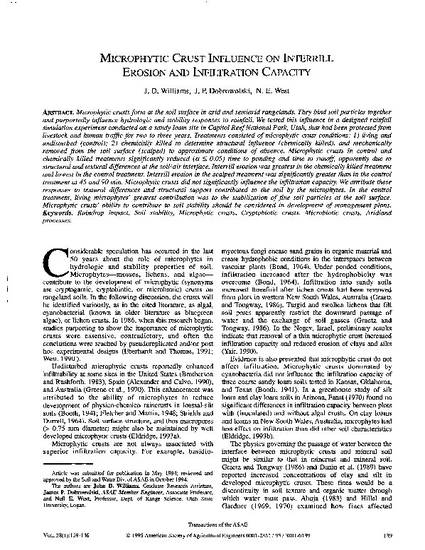
Article
Microphytic crust influence on interrill erosion and infiltration capacity
Transactions of the ASAE
(1995)
Abstract
Microphytic crusts form at the soil surface in arid and semiarid rangelands. They bind soil particles together and purportedly influence hydrologic and stability responses to rainfall. We tested this influence in a designed rainfall simulation experiment conducted on a sandy loam site in Capitol Reef National Park, Utah, that had been protected from livestock and human traffic for two to three years. Treatments consisted of microphytic crust conditions: 1) living and undisturbed (control); 2) chemically killed to determine structural influence (chemically killed), and mechanically removed from the soil surface (scalped) to approximate conditions of absence. Microphytic crusts in control and chemically killed treatments significantly reduced (a = 0.05) time to ponding and time to runoff, apparently due to structural and textural differences at the soil/air interface. Interrill erosion was greatest in the chemically killed treatment and lowest in the control treatment. Interrill erosion in the scalped treatment was significantly greater than in the control treatment at 45 and 90 min. Microphytic crusts did not significantly influence the infiltration capacity. We attribute these responses to textural differences and structural support contributed to the soil by the microphytes. In the control treatment, living microphytes greatest contribution was to the stabilization of fine soil particles at the soil surface. Microphytic crusts ability to contribute to soil stability should be considered in development of management plans.
Disciplines
Publication Date
1995
DOI
doi: 10.13031/2013.27822
Citation Information
Neil E. West. "Microphytic crust influence on interrill erosion and infiltration capacity" Transactions of the ASAE Vol. 38 Iss. 1 (1995) p. 139 - 146 Available at: http://works.bepress.com/neil_west/131/
